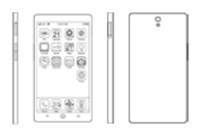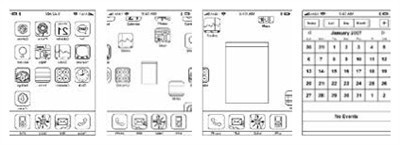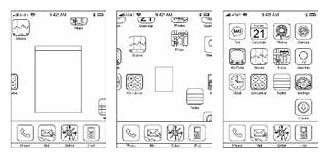On March 17th 2014, the State Intellectual Property Office of China (SIPO) announced an amendment to the Guidelines for Patent Examination (the Guidelines), which have been effective since May 1st, 2014. The amendment introduces an important change into the current design patent law system, which is that the Graphic User Interface (GUI) embodied in articles/products is eligible for design patent protection.
In this regard, please find below our comments and explanations about the new provisions concerning GUI-related designs in China.
I. Eligible subject matter for GUI design
What is a GUI design? The function keys and functional components of equipment are transformed into and displayed on an electronic GUI. The functions of the equipment can be implemented through operating this GUI. The GUI displayed on the equipment therefore constitutes a necessary part thereof.
GUIs on their own are not patentable. GUIs are merely designed for aesthetic effects and surface ornamentation are excluded from patent protection. Only GUIs designed for articles belong to the scope of, “new designs suitable for industrial application,” as provided by the Patent Law of the PRC.
However, the question remains, “How is a GUI design eligible for patent protection from a design that is only a surface ornamentation?” This issue does need to be clarified. The amendment of the Guidelines provides two principles to resolve this problem, namely, the concepts of being “associated with human machine interaction” and “closely related to carrying out product functions.” That is to say, in order to be eligible for patent protection, the GUI design must have an interactive human-machine function and enable the equipment to perform its functions.
Below are some examples commonly seen in the market to further illustrate the eligible subject matter for GUI design:
1. GUI for equipment
The first example of GUI is inherently embodied in the particular equipment and enables the equipment to carry out its functions. This kind of GUI is specifically designed for a particular device or equipment and would not suit another kind of device.
The image shown is neither associated with human-machine interaction, nor closely related to carrying out product functions.
The image shows an interaction between the equipment and a human in the process of the equipment carrying out its functions.
2. GUI of an operating system The second example of the GUI is not specific, but it still stays in close integration with the equipment and constitutes an essential part of its functions.
The second example of the GUI is not specific, but it still stays in close integration with the equipment and constitutes an essential part of its functions.
The image shows an interaction between the equipment and a human in the process of the equipment carrying out its functions.
The image shows an interaction between the equipment and a human in the process of the equipment carrying out its functions.
3. GUI for APP or software interface
The third example of the GUI is for an APP or software interface. Compared to the first two examples, this kind of GUI is neither specific for, nor inherently embodied in the equipment, but it still reflects an interaction between a human and the equipment and is necessary for carrying out its functions.


The images show an interaction between a human and the product with a GUI necessary for carrying out the equipment functions.
II. Ineligible subject matter for GUI-related design
In the amendment of the Guidelines, there is a list of 11 items that are ineligible for a design patent. Item No.11 is, “(11) Game interface, and the pattern (shown on a display device) having no association with human computer interaction or carrying out the device functions, for example, wallpapers on electronic screens, images in the process of turn-on or turn-off, and layout of webpage.”
There are at least four kinds of GUIs ineligible for design patent protection: game interface, wallpapers on electronic screens, images displayed on a device in the process of turning on or off, and layout of a webpage.
Regarding the layout of a webpage, one might think the webpage should be protected just like the software interface, because it enables the users to access the information they require by operating the computer, which could be considered as a kind of interaction with the equipment.
But actually this is a misunderstanding regarding the “interaction of human machine” at least for following reasons:
1. The information linked to the webpage is provided by the remote server of the website service provider. It is the remote server which carries out the information exchange when the Internet user browses a webpage, and not the local device.
2. Even if the user visits different websites by operating the device, linking to different websites is actually carried out by the web-browser software, not by the local device.
In one word, the webpage layout is unrelated to the human-machine interaction and does not carry out device functions.
The image shown is neither associated with human machine interaction, nor closely related to carrying out product function
The image shows an interaction between the equipment and a human in the process of the equipment carrying out its functions.
III. Types of GUI-related design applications
There are two types of GUI designs for applications:
The first one is a “static design,” which refers to, for example, the layout of graphical interfaces for operating devices, generally constituted by graphic elements. It contributes significantly to visual effects of the products. Typical examples of the static GUI design are: cameras with an operating system and homepages with Windows 8 or Apple IOS User Interfaces.
The second type is a “dynamic design,” which depicts a dynamic process of interaction between the device and the user. Differing from the static GUI design, the dynamic design seeks to protect a dynamic process in a graphical and visible manner. Therefore, it is bound to play an important role in the design patent law system because of its special features.
Compared with the static GUI, the dynamic GUI represents the visual effects in an even more significant way. It also provides an effective supplemental for static GUI design.
In practice, the above two types of GUI designs can be used separately or in combination.
IV. Requirements for the drawings or photographs for GUI-related designs
A new provision is added by the amendment:
As to the designs for products with GUIs, the applicant should submit drawings or photographs that clearly depict the design for which patent protection is sought. Therefore, the drawings or photographs submitted should contain the view(s) of the overall product indicating the location of the GUI. If the GUI are moving images, the applicant should submit the above-mentioned overall product view showing the product at least on a certain state. For the rest of the states, the applicant can only submit the views representing key frames. The overall product view(s) together with the views of different states should be able to uniquely determine the variation trend of the moving patterns/ images.
This means that when applying for a design application with GUIs, the applicant is required to submit at least the following views:
a. For a static GUI design, drawings or photos of the whole product, with six-side projection views are necessary to represent the whole shape of product. The GUI can be shown in the front view demonstrating how it is incorporated with the product. The views of key frames are optional.
b. For the dynamic GUI design, it is necessary to submit six-side projection views showing the whole shape of the product with one certain state of the GUI. Besides, different views for key frames showing the transitional nature of the moving patterns/dynamic process of the design clearly are also necessary.
Since the new amendment that just entered into force in May, there is no existing Chinese GUI design patent yet. However, we may learn a lot from the mature GUI design practices in the United States and Japan.
To illustrate the above requirements, we use an example of a GUI design taken, after some transformation, from an actual GUI design granted in the U.S.:
Top View
According to the amendment, a description of the GUI should be included in the brief description to explain its use. If necessary, when the views cannot fully express the design sought for protection, the positions, interactive modes and the transitional nature of the GUI should be further explained.
As in the above case, it should be indicated in a brief description that the GUI shown in the front view and the views of key frames 1-7 is a dynamic GUI used to open a calendar program. The scope of the design is the whole product of the cell phone with the GUI, wherein the appearance of the moving image sequentially transitions from the key frame 1 to frame 7.
V. Protection scope of GUI-related design patents
The Guidelines provide that the subject matter of protection is the whole product with the GUI, not the GUI itself.
The scope of protection covers the overall shape, structure, pattern of a product, and any combination thereof. A design can be granted a patent because it gives an industrial product a distinguishable or unique overall appearance. In case of infringement, the object of observation and comparison is the design in its entirety, other than some characteristics or just a part of the design. Therefore, the scope of protection for a design patent is the design of the overall product.
During the drafting process of the amended Guidelines some IP experts in China expressed their concern about how to realize and safeguard the interests of GUI design patentees. According to the overall product principle, it would be unavoidable to include both the outer shape of the device and the GUI image into the scope. The experts worried that the infringers can easily get around the protection scope by making some changes in the device. In that case, it would be unfair to the patentee. How is it decided when the GUI images and transitional trend are the same, while the shape of the outer device showing the GUI is totally different?
The amended Guidelines take the above suggestions into consideration. It deals with the problem to some extent by providing that, “as far as the product design contains a GUI, if the other parts of the design concerned are regarded as common designs, the GUI shall be considered as having a notable influence on the overall visual effect of the product.”
Obviously, this new provision gives a much higher importance to the GUI than that of the other parts and stresses the significant impact of the GUI on the overall visual effect.
According to the current design patent system, a design for a part of a product, which cannot be separated from the whole product, is still not available for protection in China. Therefore, emphasizing the importance of the GUI part, when judging the differences between a GUI design patent and prior art, is definitely a good choice for offering an appropriate protection to GUI designs.
Nevertheless, this still cannot solve the problem completely. At present, we can only hope that the partial design system can be passed in the next amendment of the Patent Law. This would definitely solve the problem.
VI. Filing strategy
In order to have a good chance to obtain the registration of a GUI-related design, we propose the following:
For one GUI image, we may take advantage of the Relevancy Design System (similar to the principle of “multiple design” in Europe) so as to include as much equipment as possible into one application.
However, the “Relevancy Design” can only incorporate products in the same Locarno subclass, which is different from the “multiple design” in Europe. For example, a smart phone may not be filed together with a tablet computer. If you would like to extend the protection into other products/ devices, you have to file another application for the same GUI elements, but for a different device.
Below are some possible filing methods:
1. Single one-design application: one GUI image(s) + one device
2. One relevancy design application: one GUI image(s) + a set of different devices (the same kind of device with different outer shapes)
3. One relevancy design application: a set of different GUI images (with similar image or transitional trend with each other) + one same device
The applicant may select one of the above options depending on the product features and target market expectations. Generally speaking, options 2 and 3 have broader protection than the first one.
VII. An assessment of the GUI design patent
Making GUI-related designs eligible for patent protection is a significant change. It will influence the current system in many aspects which has both advantages and disadvantages.
On the one hand, the GUI design definitely brings a new method for the patentee to claim his rights and interests. Before that, the GUI could only be protected by copyright, trademark and trade dress. The copyright only granted a relatively narrow scope of protection because many design elements could not be protected, and trade dress was only suitable for the GUI which is nonfunctional, whereas the design patent seeks to protect the GUI image when it is incorporated into a manufactured product, and it therefore contributes an important complement to the copyright and trade dress system.
Yet, a lot of details still have not been clarified. For example, how to understand the protection scope of GUI designs and what role does an outer device or a display provide a GUI design, especially in the judgment of similarity? Those issues require further explanation by law makers. In summary, the GUI design can bring great benefits for electronics manufacturers and Internet companies both domestic and foreign. Although this system in China is not mature yet, it is moving in the right direction.










